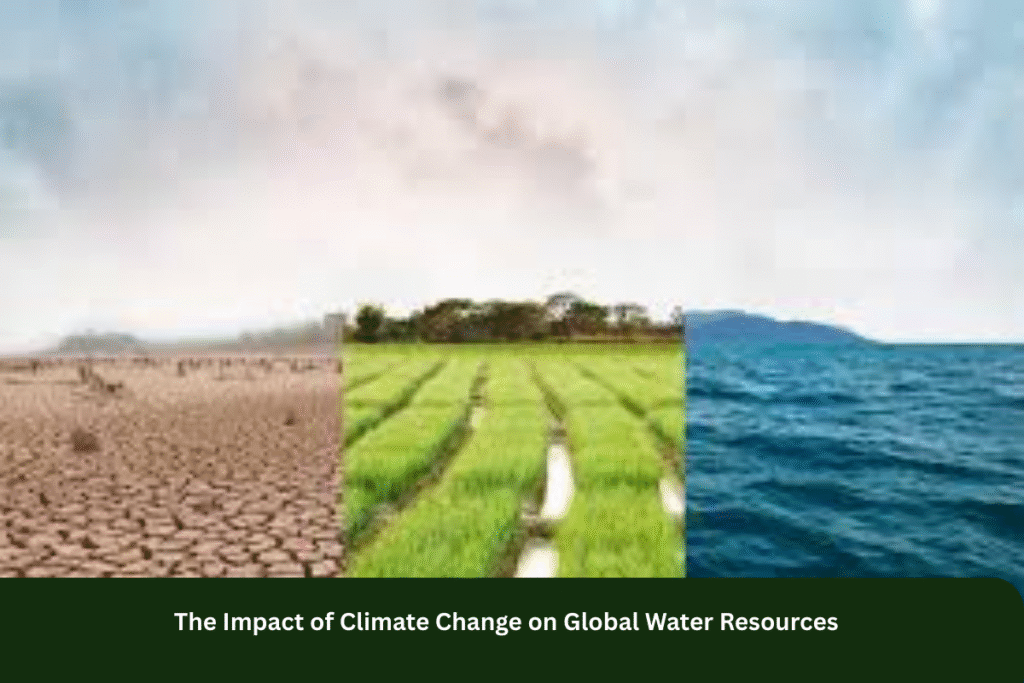
Water is essential for life, yet it is increasingly threatened by the ongoing impacts of climate change. As global temperatures rise, precipitation patterns shift, and extreme weather events become more frequent, water resources—both in terms of availability and quality—are being significantly affected. The consequences of these changes are far-reaching, impacting ecosystems, agriculture, and communities around the world. In this article, we will explore the impact of climate change on global water resources, the challenges faced, and potential solutions to ensure sustainable water management.
1. How Climate Change Affects Water Resources
Climate change alters the natural water cycle in numerous ways, affecting the distribution, availability, and quality of water across the globe. Here are some of the key ways climate change impacts water resources:
a. Shifting Precipitation Patterns
As global temperatures rise, weather patterns are shifting, leading to changes in precipitation. Some regions are experiencing more intense rainfall and flooding, while others are facing prolonged droughts and reduced rainfall.
- Increased Rainfall and Flooding: Higher temperatures increase the amount of water vapor in the atmosphere, leading to heavier rainfall in some areas. This can cause more frequent and severe floods, overwhelming infrastructure, disrupting ecosystems, and contaminating water supplies.
- Decreased Rainfall and Droughts: In many parts of the world, especially in arid regions, climate change is leading to decreased rainfall and more frequent droughts. This results in reduced river flows, lower groundwater levels, and less water available for agriculture, drinking, and sanitation.
b. Melting Glaciers and Snowpacks
Many of the world’s freshwater resources come from glaciers and snowpacks, which act as natural reservoirs, slowly releasing water into rivers and lakes during warmer months. Climate change is causing glaciers and snowpacks to melt at an accelerated rate, which has several impacts:
- Water Availability: While melting glaciers initially increase water flow, over time, this process leads to reduced water availability as glaciers shrink and eventually disappear. Regions that rely on glacial meltwater for their water supply may experience water shortages in the future.
- Seasonal Disruptions: In areas dependent on snowmelt for irrigation and drinking water, changes in the timing and volume of meltwater can disrupt agricultural schedules, leading to crop failures and water scarcity.
c. Rising Sea Levels and Saltwater Intrusion
Rising sea levels caused by global warming are another serious threat to freshwater resources. As coastal areas are inundated, saltwater intrusion into freshwater aquifers is becoming more common.
- Contamination of Freshwater Sources: In low-lying coastal regions, saltwater can seep into underground freshwater reserves, making water supplies undrinkable and unusable for irrigation. This forces communities to find alternative water sources, often at great expense.
- Threat to Agriculture: Saltwater intrusion can also affect agricultural lands near coastal areas, reducing soil fertility and making it difficult to grow crops that rely on freshwater irrigation.
d. Increased Evaporation Rates
Higher temperatures are causing increased evaporation rates from rivers, lakes, and reservoirs. As water evaporates faster, there is less water available for human consumption, agriculture, and ecosystems.
- Reduced Water Supply: In areas already experiencing water scarcity, higher evaporation rates exacerbate the problem by further reducing the available water supply.
- Impacts on Hydroelectric Power: Many countries rely on hydroelectric dams to generate electricity. Reduced water levels due to evaporation can lead to decreased energy production, affecting both energy security and the economy.
2. The Global Impact of Climate Change on Water Resources
The impacts of climate change on water resources are felt differently across various regions of the world, depending on local climate conditions, geography, and infrastructure. Some of the most affected regions include:
a. Sub-Saharan Africa
Sub-Saharan Africa is one of the regions most vulnerable to the impacts of climate change on water resources. The region already faces high levels of water stress, and climate change is exacerbating the problem with more frequent droughts, unpredictable rainfall, and declining groundwater levels. This leads to food insecurity, migration, and heightened competition for water.
b. Asia
Asia, home to some of the world’s most densely populated regions, is facing significant challenges related to water availability and quality. Countries like India and China rely heavily on glacial meltwater from the Himalayas, which is decreasing due to rapid glacial retreat. Additionally, urbanization and industrialization are placing growing demand on already limited water resources.
c. The Middle East and North Africa
The Middle East and North Africa (MENA) region is already one of the driest parts of the world, and climate change is making it even more arid. The region is expected to face worsening droughts, reduced rainfall, and increasing water demand from agriculture, exacerbating the water scarcity crisis.
d. Small Island Developing States (SIDS)
Small island nations are particularly vulnerable to the combined impacts of rising sea levels and water scarcity. With limited freshwater resources and a high dependence on imported water, these nations face a growing threat to their water security as saltwater intrusion and droughts become more frequent.
3. Solutions for Sustainable Water Management
Addressing the impact of climate change on water resources requires a multi-faceted approach that includes both mitigation and adaptation strategies. Here are some potential solutions to ensure sustainable water management in the face of climate change:
a. Water Conservation and Efficiency
Improving water efficiency in agriculture, industry, and households is crucial to reducing the demand for water. This includes:
- Adopting efficient irrigation systems such as drip irrigation to minimize water waste.
- Using water-saving technologies in industries and households to reduce consumption.
- Encouraging responsible water usage through awareness campaigns and policy measures.
b. Investing in Water Recycling and Reuse
Water recycling and reuse are vital strategies for maximizing the use of available water. This includes:
- Recycling wastewater for non-potable uses such as irrigation and industrial processes.
- Developing desalination technologies to convert seawater into freshwater, especially in coastal regions affected by saltwater intrusion.
c. Protecting and Restoring Ecosystems
Healthy ecosystems, such as wetlands, forests, and watersheds, play an essential role in regulating water cycles and maintaining water quality. Protecting these ecosystems and restoring degraded ones can enhance water storage capacity, reduce flooding, and improve water quality.
d. Developing Climate-Resilient Infrastructure
Building climate-resilient infrastructure, such as dams, reservoirs, and water distribution systems, is essential for ensuring reliable access to water in a changing climate. Investment in infrastructure that accounts for future climate conditions can help communities adapt to changing water availability.
4. FAQs
1. How does climate change affect global water resources?
2. What regions are most affected by water scarcity due to climate change?
3. How can water conservation help mitigate the effects of climate change on water resources?
4. What are some ways to combat saltwater intrusion into freshwater aquifers?
5. How can investing in water infrastructure help address climate change impacts?
5. Conclusion
The impact of climate change on global water resources is a pressing issue that requires immediate attention and action. As water availability and quality become increasingly uncertain, it is crucial to adopt sustainable water management practices, invest in resilient infrastructure, and protect ecosystems that regulate water cycles. By taking proactive steps to address the challenges posed by climate change, we can ensure that future generations have access to clean, reliable water resources.
ChatGPT can make mistakes. Check important info. See Cookie Preferences.
